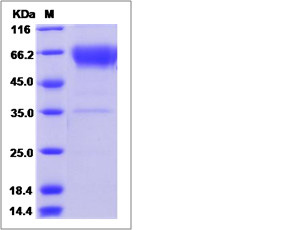Rat BTLA Protein (ECD, Fc Tag)
BTLA
- 100ug (NPP1093) Please inquiry
| Catalog Number | P81142-R05H |
|---|---|
| Organism Species | Rat |
| Host | Human Cells |
| Synonyms | BTLA |
| Molecular Weight | The recombinant rat Btla consists 384 amino acids and predicts a molecular mass of 43.4 kDa. |
| predicted N | Lys 30 |
| SDS-PAGE |  |
| Purity | > 90 % as determined by SDS-PAGE. |
| Protein Construction | A DNA sequence encoding the rat Btla (NP_998795.1) (Ala6-Tyr183) was expressed with the Fc region of mouse IgG1 at the C-terminus. |
| Bio-activity | 1. Measured by its binding ability in a functional ELISA. 2. Immobilized rat BTLA-mFc at 10 μg/mL (100 μL/well) can bind mouse HVEM-Fch (P10567-M03S). The EC50 of mouse EFNA5-Fc (P50597-M02H) is 6.2-14.4 ng/mL. |
| Research Area | Signaling |Signal Transduction |ITIM/ITAM Immunoreceptors and Related Molecules |
| Formulation | Lyophilized from sterile PBS, pH 7.4. 1. Normally 5 % - 8 % trehalose, mannitol and 0.01% Tween80 are added as protectants before lyophilization. Specific concentrations are included in the hardcopy of COA. |
| Background | BTLA is a inhibitory molecule which belongs to the Ig superfamily. It down-modulates immune responses. As such, reagents that regulate the binding of BTLA to its ligand or alter BTLA signaling have significant therapeutic promise. BTLA is crucial to understand the mechanism(s) of action of these antibodies before attempting clinical applications. BTLA is not expressed by naive T cells, but it is induced during activation and remains expressed on T helper type 1 (T(H)1) but not T(H)2 cells. BTLA is a third inhibitory receptor on T lymphocytes with similarities to cytotoxic T lymphocyte-associated antigen 4 (CTLA-4) and programmed death 1 (PD-1). |
| Reference |
